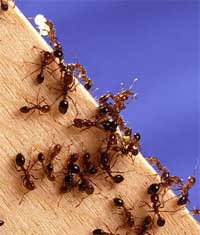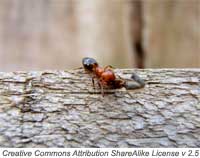
 A typical Fire ant colony produces large mounds in open areas, and feeds primarily on young plants and seeds. Fire ants often attack small animals and can kill them. Unlike many other ants, which bite and then spray formic acid on the wound, Fire ants only bite to get a grip and then sting (from the abdomen) and inject a toxic alkaloid venom. For humans, this is a painful sting — hence the name Fire ant— and the aftereffects of the sting can be deadly to sensitive individuals. The venom is both insecticidal and antibiotic. Researchers have proposed that nurse workers will spray their brood to protect them from microorganisms. The worker ants are blackish to reddish and vary from 3–6 mm in length. A typical Fire ant colony produces large mounds in open areas, and feeds primarily on young plants and seeds. Fire ants often attack small animals and can kill them. Unlike many other ants, which bite and then spray formic acid on the wound, Fire ants only bite to get a grip and then sting (from the abdomen) and inject a toxic alkaloid venom. For humans, this is a painful sting — hence the name Fire ant— and the aftereffects of the sting can be deadly to sensitive individuals. The venom is both insecticidal and antibiotic. Researchers have proposed that nurse workers will spray their brood to protect them from microorganisms. The worker ants are blackish to reddish and vary from 3–6 mm in length.
Fire ants nest in the soil, often near moist areas, such as river banks, pond edges, watered lawns and highway edges. A single nest is usually less than a square yard (square meter), and may have several small openings on the surface or in fissures; the ants shift the entrance during the season and may transport immature ants between openings.
Most fire ant species are unobtrusive, and rarely come into contact with humans; of the few that do, most do not attain the status of serious pests, as they are kept in check by parasites, predators, and competition with other ants. However, at least one species, Solenopsis invicta, commonly known as the Red imported fire ant (RIFA), has been moved around the world from its native range in South America and, in the absence of its predators and parasites, has become a major pest nearly everywhere it has been introduced, as is common for invasive species. This species was accidentally introduced into the United States via Brazilian cargo entering the port of Mobile, Alabama, in the 1930s. The ants have since spread from coastal areas of Alabama and now infest large parts of the Southern U.S., and have created a nuisance to farmers and homeowners alike from California to Maryland. Since 2001, this species has been spread to eastern Australia, the Philippines, Taiwan, and China.
 In the southern United States phorid flies have been imported as an attempt to control fire ants by natural means. The genus Apocephalus, or ant-decapitating fly, of which 110 species have been documented, is a parasite of the ant in South America. Members of Apocephalus reproduce by laying eggs in the head of the ant. The larvae eat the contents of the fire ant's head and emerge several days later. The phorid flies have been widely introduced throughout the U. S. Southeast, starting with Travis, Brazos, and Dallas counties in Texas, as well as Mobile, Alabama, where the ants first entered North America. Not all introductions have been successful, but the fly has been established in some sites in every southeastern state. In the southern United States phorid flies have been imported as an attempt to control fire ants by natural means. The genus Apocephalus, or ant-decapitating fly, of which 110 species have been documented, is a parasite of the ant in South America. Members of Apocephalus reproduce by laying eggs in the head of the ant. The larvae eat the contents of the fire ant's head and emerge several days later. The phorid flies have been widely introduced throughout the U. S. Southeast, starting with Travis, Brazos, and Dallas counties in Texas, as well as Mobile, Alabama, where the ants first entered North America. Not all introductions have been successful, but the fly has been established in some sites in every southeastern state.
 Nuptial flights, when males and queens seek out mates and new nests, occur each year. Colonies are founded by small groups of queens or single queens. Only one queen survives, and within a year or so, the colony expands into thousands of individuals. Nuptial flights, when males and queens seek out mates and new nests, occur each year. Colonies are founded by small groups of queens or single queens. Only one queen survives, and within a year or so, the colony expands into thousands of individuals.

In Spanish, fire ants are known as hormiga colorada (red ant) or hormiga brava (surly ant). In Portuguese, they are called formiga de fogo (fire ant), formiga lava-pé (wash foot ant) and formiga toicinheira (lard ant).
All text is available under the terms
of the GNU Free Documentation License
|

